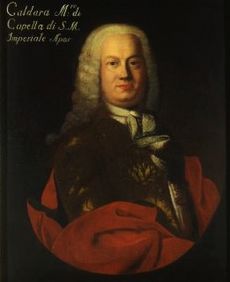Antonio Caldara facts for kids
Antonio Caldara (born around 1670 – died December 28, 1736) was a famous Italian Baroque composer. He wrote many different kinds of music, including operas and oratorios.
Contents
Life of Antonio Caldara
Caldara was born in Venice, Italy. We don't know his exact birth date. His father was a violinist. Antonio started as a singer, called a chorister, at St Mark's in Venice. There, he learned to play several musical instruments. He probably learned from a teacher named Giovanni Legrenzi.
Early Career and Travels
In 1699, Caldara moved to Mantua. He became the maestro di cappella, which means the music director, for Charles IV, Duke of Mantua. This duke was involved in the War of the Spanish Succession. Caldara left Mantua in 1707 after the French forces were pushed out of Italy.
He then moved to Barcelona, Spain. There, he worked as a chamber composer for Charles III. Charles III was trying to become the king of Spain. Caldara wrote some operas in Barcelona. These were the first Italian operas ever performed in Spain.
After Barcelona, he moved to Rome. He became the music director for Prince Francesco Maria Marescotti Ruspoli, 1st Prince of Cerveteri. In 1710, while in Rome, he wrote an opera called La costanza in amor vince l'inganno. This means Faithfulness in Love Defeats Treachery. It was for a public theater in Macerata.
Moving to Vienna
In 1711, Emperor Joseph I died suddenly. Caldara decided it was a good idea to reconnect with Charles III. Charles III was traveling from Spain to Vienna and would soon become the new Holy Roman Emperor, Charles VI.
Caldara visited Vienna in 1712. However, he found that two other composers, Marc'Antonio Ziani and Johann Joseph Fux, already held the top music jobs. On his way back to Rome, he stopped at the Salzburg court. They liked his music there. From 1716 to 1727, he sent one new opera to Salzburg every year.
In 1716, Caldara finally got a big job in Vienna. He was appointed Vize-Kapellmeister, or Vice-Music Director, for the Imperial Court. He stayed in Vienna until he passed away.
Caldara's Musical Legacy
Antonio Caldara was a very busy composer. He wrote over 70 operas. He also created more than 30 oratorios. Oratorios are like operas but without costumes or acting. He also wrote many other pieces, such as motets and sonatas.
Many of his works used words, called libretti, written by Pietro Metastasio. Metastasio was a famous poet who worked for the court in Vienna starting in 1729.
Noted Musical Works
Here are some of Antonio Caldara's most well-known musical works:
Operas
- Sofonisba (1708)
- Il più bel nome (1708)
- Tito e Berenice (1714)
- Lucio Papirio dittatore (1719)
- I disingannati (1729)
- Adriano in Siria (1732)
- L'Olimpiade (1733)
- La clemenza di Tito (1734)
- Achille in Sciro (1736)
Oratorios
- Maddalena ai piedi di Cristo (around 1700)
- Santo Stefano, primo Re d'Ungheria (1713)
- La Conversione di Clodoveo Re di Francia (1715)
- La passione di Gesù Cristo (1730)
- Il Re del dolore (1722)
- Stabat Mater (around 1725)
Other Works
- Il più bel nome, a serenata for the wedding of Archduke Charles of Austria (1708)
- "Sebben, crudele" (a song from La costanza in amor vince l'inganno, 1710)
- D'improvviso (a cantata)
- "Alma del core" (a song)
- "Selve amiche" (a song)
- Missa Providentiae (a mass)
- Missa Dolorosa (1735) (a mass)
- La Costanza vince il rigore (a cantata)
- Crucifixus
- Come Raggio di Sol
- Christmas Cantata
See also
 In Spanish: Antonio Caldara para niños
In Spanish: Antonio Caldara para niños


